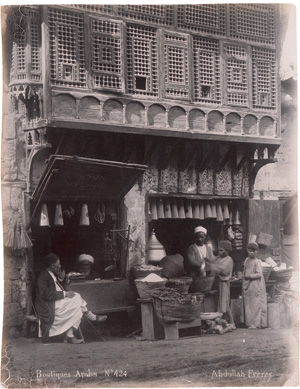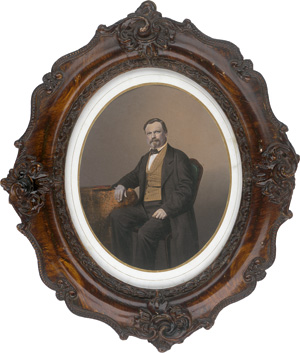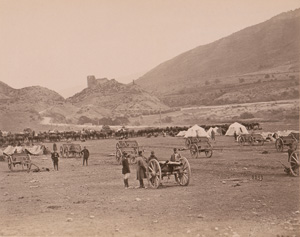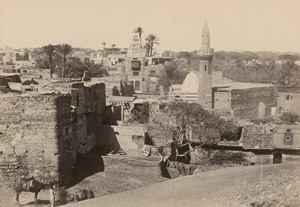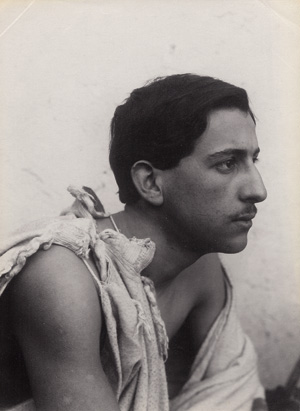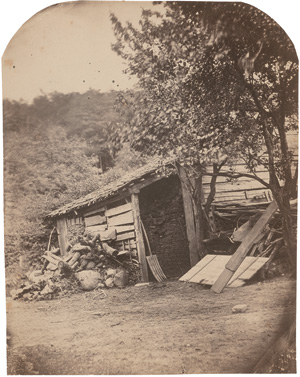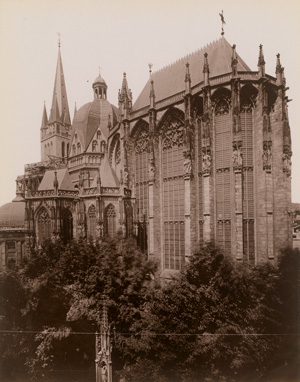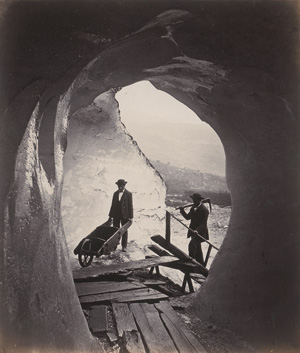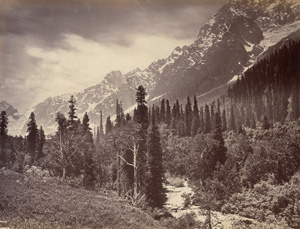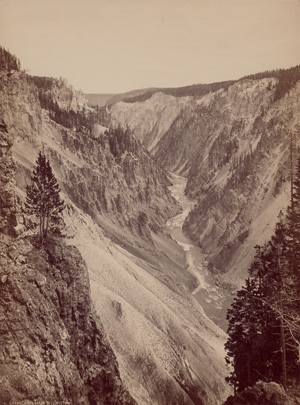Photographers: Pascal Sébah (1823-1886), Abdullah Frères (active 1858-1900), Luigi Fiorillo (active ca. 1850s-1880s). Views of Egypt. 1880s-1890s. 57 albumen prints mounted to gilt-edged album pages (slightly soiled, some foxing). Each ca. 21 x 27 cm (26 x 35,5 cm) or reverse. Each numbered, titled and signed in negative on lower portion of print. Bound in full-parchment album with gilt-embossed ornamentation.
This album comprises a variety of views of Cairo, featuring iconic landmarks such as the Pyramids of Giza, the Citadel, and the Mosques of Sultan Hassan, Sultan Barquq, and Muhammad Ali, along with the City of the Dead and the Mosque of Amr ibn al-As. It also captures scenes of daily life, including students studying the Qur’an and a muezzin calling to prayer. Additionally, the album contains photographs of several artifacts from the Grand Egyptian Museum in Cairo, as well as views of the Ezbekieh Gardens and the Palace of Gezira. – Some scuff marks, fading and signs of oxidation along edges of prints, otherwise in good condition.
Emden, Hermann
Portraits of husband and wife
Los 4032
Ergebnis (inkl. Aufgeld) *
1.250€ (US$ 1,420)
Portraits of husband and wife. 1850s. 2 hand-colored salted paper prints in ornately carved wooden frames (slightly scratched). Each ca. 19 x 15,5 cm (37 x 31 cm). Photographer's studio stamp embossed on mount below image, one with photographer's label attached to frame verso, both annotated in blue ink on frame verso.
Hermann Seligmann Emden was a German copper engraver, lithographer, and photographer recognized for his contributions to early photography and credited with creating one of Germany’s first photographically illustrated books. He adeptly combined traditional printmaking techniques with innovative photographic methods, capturing a diverse range of subjects, including landscapes, architectural details, and portraits. – In very good condition.
Ermakov, Dimitri Ivanovich
Georgian Military Road
Los 4033
Ergebnis (inkl. Aufgeld) *
2.000€ (US$ 2,273)
Georgian Military Road. 1883. 30 albumen prints mounted to album pages (slightly soiled). Each between 10,7 x 13,8 cm and 13,2 x 21,7 cm (23,7 x 31,5 cm). Each with photographer's embossed signature stamp in lower right corner of print and titled in pencil below image on mount. Bound in full-canvas album (corners rubbed) with gilt-stamped title Grusinische Militärstrasse Wladikawkas-Tiflis, Reise 1883 and small map from 1875 on the inside cover.
This 1883 album documents the Georgian Military Road, a historic route through the Caucasus Mountains linking Vladikavkaz and Tbilisi. Photographed by Dmitri Ivanovich Ermakov, who began his career in 1868, the images capture dramatic landscapes, landmarks, and settlements along the route. Widely regarded as the foremost documentarian of Georgian life in the late 19th and early 20th centuries, Ermakov traveled extensively across the region. His legacy is preserved by the National Museum of Georgia, which houses a significant collection of his negatives. – Some small surface irregularities and light fading, otherwise in very good condition.
Frith, Francis
Egypt, Sinai and Palestine
Los 4035
Ergebnis (inkl. Aufgeld) *
3.500€ (US$ 3,977)
Egypt, Sinai and Palestine. 1862. Bound volume with a total of 37 albumen prints mounted to album pages (some foxing). Each circa 16 x 23 cm or reverse. The majority signed and numbered in negative, each with printed caption on mount. With contents, title and illustration on frontispiece. Bound in green leather-backed cloth album (corners rubbed, spine torn) with gold-embossed title on front cover (cover loose). William MacKenzie, London, Glasgow & Edinburgh, 1862.
Francis Frith, initially an apprentice in a cutlery business and later a partner in a grocery firm, shifted his focus to photography in the early 1850s. Between 1856 and 1860, he embarked on three expeditions to Egypt, Sinai, and Jerusalem, capturing striking images of ancient monuments using the wet collodion process. This Supplementary Volume to Egypt, Sinai, and Palestine features some of his earliest photographs of iconic sites, including Cairo, the Pyramids at Giza, Thebes, Luxor, the temples at Karnak, as well as significant locations like Jerusalem, Damascus, Gaza, and Nubia. Frith’s work played a pivotal role in fueling the growing Western fascination with Egyptology and the region’s cultural heritage. – Some foxing and time-staining on album pages, some prints slightly faded along edges, some with minimal surface scuff marks, otherwise in very good condition.
Galdi, Vincenzo
Portrait of a youth in Roman tunic
Los 4036
Ergebnis (inkl. Aufgeld) *
875€ (US$ 994)
Portrait of a youth in Roman tunic. Circa 1900. Albumen print. 22,3 x 16,5 cm. Photographer's stamp, address "Via Campania lett: B Roma" and number "1156" in blue crayon on the verso.
Vincenzo Galdi was an Italian photographer and protégé of Wilhelm von Plüschow, celebrated for his contributions to nude photography. Originally a model in many of his mentor’s photographs, Galdi quickly gained a reputation as one of the most prolific and bold nude photographers in Naples and later in Rome during the late 19th century. – Some light handling marks, pressure marks in corners from album slits, some fading in edges, otherwise in very good condition.
Farmyard near Hamburg. 1857. 2 albumen prints with cut/rounded corners. Each circa 12 x 9,5 cm. Each mounted to original board, each signed by the artist in ink in lower right on mount.
The German painter Berend Goos sold 64 of his works to the Hamburg Art Association (HH Kunstverein) in 1855, 1859, and 1864. He frequently photographed landscapes and rural scenes, using them as references for his paintings. – One with a few light spots in upper left, minimal fading in edges, otherwise in good condition. With: Berend Goos. Two pencil drawings and one oil sketch of clouds. 1853-1879. Some traces of use, some pinholes in corners, a few spots.
Provenance: Robert Lebeck Collection
Photographers: Giorgio Sommer (1834-1918), Alfred Noack (1833-1895), Achille Mauri (1806-1883) and Francesco Bosetti (dates unknown). Travel album of the Grand Tour. 1890s. 110 albumen prints mounted to album pages (some loose). Each between 17,5 x 22,5 cm and 22 x 28 cm or reverse (36 x 45 cm). Some titled and numbered in negative on lower margin. Bound in richly carved full-leather album (some scratches on back cover, edges rubbed).
This 19th-century travel album features a selection of photographs from key European cultural and scenic destinations, including Heidelberg, Aachen, London, Holland, Switzerland, Genoa, Lago di Como, Lago Maggiore, Naples, Amalfi, Pompeii, and Paestum. – Some fading, otherwise all in good to very condition.
Photographer: Charnaux frères (attributed to). Grotte de Grindelwald. 1860s. Gold-toned albumen print. 18,7 x 16 cm. Mounted to card, annotated in ink below the image on the mount.
The Grindelwald Glacier was one of the most breathtaking glacier formations in Switzerland, featuring towering ice structures and unusual shapes. By 1855, it had descended to the valley floor. In 1863, the Bernese company Schegg & Böhlen received a concession for commercial ice mining. The harvested ice blocks were transported to Interlaken and exported to Paris for use as a coolant. – Minimal fading in lower edge, a few light surface scuff marks, otherwise in very good condition with strong tones.
Photographer: John Burke and William Baker (1843-1900, dates unknown), John Edward Saché (1824-1882). Views of India. 1870s. 11 albumen prints. Each 20,7 x 28 cm and smaller. Several with photographer's name and number in the negative in lower corners.
Some with surface rubbing/scratching, a few small tears, a few with foxing, traces of previous mounting on the verso, otherwise in good condition and several with strong tones.
Jackson, William Henry
Grand Canyon of the Yellowstone
Los 4044
Ergebnis (inkl. Aufgeld) *
750€ (US$ 852)
Grand Canyon of the Yellowstone. 1871/1872. Albumen print mounted to board. 33,3 x 24,7 cm. Titled in negative on lower margin; annotated in pencil by another hand, typewritten description on label attached to verso.
William Henry Jackson was a pioneering photographer celebrated for his extensive documentation of the American West in the late 19th century. His work with the U.S. Geological Survey resulted in some of the earliest images of Yellowstone, which were instrumental in its designation as the first national park. Known for his large-format and meticulously detailed landscapes, Jackson’s photographs captured the natural beauty and grandeur of iconic sites such as the Grand Tetons and Mesa Verde, making a lasting contribution to the visual heritage of the United States. – Corners slightly bumped, some light scuff marks, otherwise a fine tonal print in very good condition.
Photographer: Baron Raimund Stillfried-Ratenicz (1839-1911), Felice Beato (1832-1909), Kusakabe Kimbei (1841-1932), and unknown. Japanese portraits. 1870s-90s. 28 hand-colored albumen prints. Each circa 24 x 20 cm. Some with number and title in lower corners in the negative, most mounted to board and matted.
Baron Raimund von Stillfried-Ratenicz, Felice Beato, and Kusakabe Kimbei were influential photographers who played key roles in documenting Japan during the late 19th century. Stillfried and Beato, both foreign photographers, captured the landscapes, architecture, and people of Japan, with Beato’s work being among the first visual records of the country for Western audiences. Kusakabe Kimbei, a Japanese photographer who trained under Stillfried and Beato, became known for his hand-colored images of traditional Japanese scenes, catering primarily to Western visitors during the Meiji period.This attractive group includes photographs of street sellers, monks, priests, geishas, wrestlers, tattooed men and craftsmen. The coloring is often exceptionally subtle and finely executed. – Several faded, especially in edges, some with light scuff/handling marks, some with light spots, otherwise most in good condition.
Lit.: Claudia Gabriele Philippe/Dietmar Siegert/ Rainer Wick (eds.). Felice Beato in Japan. Photographien zum Ende der Feudal Zeit 1863-1873. Heidelberg 1991, ill. pp. 155, 160, 168 and 172.
Alfried Wieczorek/Claude W. Sui (eds.). Ins Land der Kirschblüte. Japanische Reisefotografien aus dem 19. Jahrhundert. Heidelberg 2011, ill. p. 144 (Farmer with grass coat-Kimbei).
[*]: Regelbesteuert gemäß Auktionsbedingungen. [^]: Ausgleich von Einfuhr-Umsatzsteuer.
* Alle Angaben inkl. 25% Regelaufgeld ohne MwSt. und ohne Gewähr – Irrtum vorbehalten.
Galerie Bassenge
Erdener Str. 5A
14193 Berlin
Öffnungszeiten:
Montag bis Donnerstag, 10–18 Uhr,
Freitag, 10–16 Uhr
Telefon: +49 30 8938029-0
Fax: +49 30 8918025
E-Mail: info (at) bassenge.com
Impressum
Datenschutzerklärung
© 2024 Galerie Gerda Bassenge
Galerie Bassenge
Erdener Str. 5A
14193 Berlin
Öffnungszeiten:
Montag bis Donnerstag, 10–18 Uhr,
Freitag, 10–16 Uhr
Telefon: +49 30 8938029-0
Fax: +49 30 8918025
E-Mail: info (at) bassenge.com
Impressum
Datenschutzerklärung
© 2022 Galerie Gerda Bassenge

